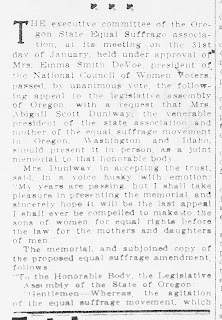As we saw for February 9, Representative Timothy Brownhill introduced House Concurrent Resolution 24 and it contained information about the Executive Committee meeting of the Oregon State Equal Suffrage Association in which members decided to ask the legislature for a vote of support for their initiative petition. The petition, completed in December 1910, placed the woman suffrage measure on the ballot for the 6th time.
An entry in suffragist and clubwoman Sarah Evans's "Women's Clubs" column in the Sunday Oregon Journal for February 19, 1911 gives us more information and context about the meeting. (Evans's column was an ongoing weekly feature and she reported on news of women's clubs, organizations, and activism throughout the state -- she was a blogger before her time . . . )
The first part of the entry is the same as that noted in the Journal of the Oregon House of Representatives that I reprinted for the February 9 blog here. The OSESA asks the legislators to vote their approval for the measure, a vote of confidence and support.
But here we learn more of the details -- and the article copy in full is below.
Evans writes: "The foregoing open letter was presented to every member of the legislative assembly on the 8th inst. [February 8, 1911] accompanied by a concurrent resolution cordially recommending its ratification by the legislature, and by the votes of men at the general election in November 1912."
As we've seen, the Senate voted on its Senate Joint Resolution 12 on February 10. We'll see what the House did in a future post for February 16.
At the end of this entry in Evans's column we find "The resolution passed the Senate on the eighth instant, with little doubt of its ratification by the house in due order of procedure." The Senate Journal says February 10 -- so I'm privileging that date as the more accurate one.
It's not clear who presented the open letter to the members of the Oregon legislature. The report Evans reprinted in her column, most probably authored by Abigail Scott Duniway or a close associate in the OSESA, puts things in the passive voice -- the "foregoing open letter was presented . . ." I could find no news article that indicated Duniway had presented it "in person" as the executive committee meeting request suggested. I strongly suspect that if Duniway, never one to shy away from publicity of any kind, had been there in person she would have noted it. Duniway does not include any mention of this in her 1914 autobiography Path breaking: An Autobiographical History of the Equal Suffrage Movement in Pacific Coast States. But the OSESA put her there in the open letter as the "mother of the equal suffrage movement in Oregon."
Come back for more on the progress of the resolutions and the vote in the House. As you might guess, there was some heated debate about this 6th try for Oregon woman suffrage in November 1912.
Sarah Evans, "Women's Clubs," Oregon Journal, February 19, 1911, 5:7.





